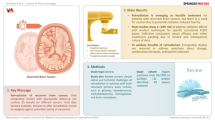Abstract
The initial management of malignant gliomas is multimodality in nature, consisting of surgery, radiation therapy and chemotherapy. However, once progression has occurred, treatment options are limited both in terms of selection and efficacy. We report a case of a 37 year-old male diagnosed with a Grade II astrocytoma initially treated with surgery and external beam radiation therapy consisting of 54 Gy delivered in 1.8 Gy fractions that subsequently progressed to a Grade IV astrocytoma. This was managed with temozolomide chemotherapy until the patient exhibited further progression. Although the patient had received prior full dose radiotherapy, he was re-treated with external beam radiotherapy delivered at a substantially reduced dose-rate. This reduction in dose-rate is obtained by delivering treatment in a series of 0.2 Gy pulses separated by 3 min time intervals, creating an apparent dose rate of 0.0667 Gy/min. The region of recurrence was treated to a dose of 50 Gy delivered using 25 daily fractions of 2.0 Gy. The patient had both a radiographic response and clinical improvement following re-irradiation using pulsed reduced dose-rate radiotherapy with no apparent acute or late neurologic toxicities at a time when other treatment options were not available. Despite delivering 104 Gy to the tumor bed and the surrounding brain parenchyma, at no time was there radiographic evidence of radiation-induced normal tissue necrosis. The radiobiologic basis for the use of pulsed reduced dose-rate external beam radiotherapy in the management of recurrent glioma patients is discussed.



Similar content being viewed by others
References
Ammirati M, et al (1987) Effect of the extent of surgical resection on survival and quality of life in patients with supratentorial glioblastomas and anaplastic astrocytomas. Neurosurgery 21(2):201–206
Walker MD, et al (1980) Randomized comparisons of radiotherapy and nitrosoureas for the treatment of malignant glioma after surgery. N Engl J Med 303(23):1323–1329
Walker MD, et al (1978) Evaluation of BCNU and/or radiotherapy in the treatment of anaplastic gliomas. A cooperative clinical trial. J Neurosurg 49(3):333–343
Stupp R, et al (2005) Radiotherapy plus concomitant and adjuvant temozolomide for glioblastoma. N Engl J Med 352(10):987–996
Hess KR, et al (1999) Response and progression in recurrent malignant glioma. Neuro-oncol 1(4):282–288
Chang SM, et al (2004) Temozolomide in the treatment of recurrent malignant glioma. Cancer 100(3):605–611
Tatter SB (2002) Recurrent malignant glioma in adults. Curr Treat Options Oncol 3(6):509–524
Durmaz R, et al (1997) Management of glioblastoma multiforme: with special reference to recurrence. Clin Neurol Neurosurg 99(2):117–123
Salcman M, et al (1994) Long-term survival in patients with malignant astrocytoma. Neurosurgery 34(2):213–219 discussion 219–220
Tomé WA, Howard SP (2006) On the possible increase in local tumor control probability for gliomas exhibiting low dose hyper-radiosensitivity using a pulsed schedule. Br J Radiology Advance 10.1259/bjr/15764945
Bauman GS, et al (1996) Reirradiation of primary CNS tumors. Int J Radiat Oncol Biol Phys 36(2):433–441
Veninga T, et al (2001) Reirradiation of primary brain tumours: survival, clinical response and prognostic factors. Radiother Oncol 59(2):127–137
Butowski NA, Sneed PK, Chang SM (2006) Diagnosis and treatment of recurrent high-grade astrocytoma. J Clin Oncol 24(8):1273–1280
Schultz CJ, Geard CR (1990) Radioresponse of human astrocytic tumors across grade as a function of acute and chronic irradiation. Int J Radiat Oncol Biol Phys 19:1397–1403
Schultz CJ, Davies BM (1994) G2M block characteristics as a function of dose rate in two human glioblastoma cell lines. In: Proceedings of the Radiation Research Society 42nd Annual Meeting, Nashville, TN
Pierquin B, et al (1991) Comparison of fractionated irradiation and low-dose rate irradiation in the local treatment of advanced breast cancer. Bulletin Du Cancer/Radiotherapie 78: 125–132
Pierquin B, et al (1985) A comparison between low dose rate radiotherapy and conventionally fractionated irradiation in moderately extensive cancers of the oropharynx. Int J Radiat Oncol Biol Phys 11(3):431–439
Author information
Authors and Affiliations
Corresponding author
Rights and permissions
About this article
Cite this article
Cannon, G.M., Tomé, W.A., Robins, H.I. et al. Pulsed reduced dose-rate radiotherapy: case report. J Neurooncol 83, 307–311 (2007). https://doi.org/10.1007/s11060-007-9329-z
Received:
Accepted:
Published:
Issue Date:
DOI: https://doi.org/10.1007/s11060-007-9329-z




